#speed of sound in different mediums in Hindi
Text
A Tale of Modern India —A story of 'Bollywood'
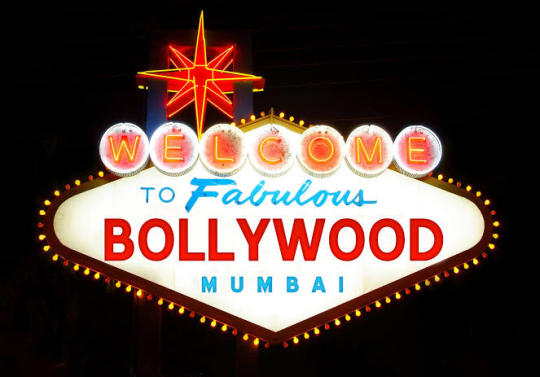
The term 'Bollywood' generally refers to the Hindi-language movie industry based in Mumbai (formerly Bombay). Amit Khanna, a journalist, coined the term 'Bollywood' in the 1970s as a fusion of 'Bombay' and 'Hollywood'. Bollywood has definitely surpassed Hollywood in terms of the centre of film production. This is now the largest in the world. As cinema is the largest and most popular entertainment format in India, and Bollywood is the largest producer of the product to satisfy its needs.
The story of Bollywood automatically shows the story of India itself. With the combination of ancient storytelling and dancing tradition, the struggles for political and economic independence, social problems, self-confidence, cultural vibrancy, and increasing commercialism at the expense of spiritualism. With these, Bollywood has made its presence on the world stage and screen.
Landmarks of Hindi-language cinema:
1913 => first silent film, Raja Harishchandra
1931 => first sound film, Alam Ara
1937 => first colour film, Kisan Kanya
During the 1930s and 1940s, the concept of film stars came in India, a tradition which is being continued to this day. Bollywood stars are more idolized and venerated than Hollywood stars.
Bollywood is famous for its lavish musicals, escapist fantasies, energy and glamour as compared to serious scripts or acting (as well as risible sound quality in the period up to the 1990s).
Cinematic masterpieces:
Panther Panchali (1955), Mother India and Pyaasa (both in 1957), and Salaam Bombay (1988). At that time, there were world-leading directors such as Satyajit Ray and Guru Dutt, and distinguished actors such as Amitabh Bachchan. Several generations of Indian film directors have developed a parallel cinema to the extravaganzas of commercial Bollywood which is more focused on social realism and social problems primarily on major cities.
The marketing techniques used to promote Bollywood and its films have become more complex. The cost for marketing Bollywood films are now taking a significant share of the production budget. Many Indian producers are complaining about the rising importance of the marketing plan which is often longer than the script and more costly than the production. In the highly competitive, Indian and international market, often the best marketing decides the most lucrative films.
During the early days of Bollywood, marketing done by posters, handbills, print ads, and billboard were enough to lure mass audiences to cinemas. At that time, in a single film there was a lot of general entertainment in order to attract mass audience and high box office return. Films were of composite entertainments rather than divided into genres. In one film, it has lots of elements such as songs, dance routines, melodrama, heros and villains, family conflicts, special effects, adventure storylines, suspense, action, crime, and romantic triangles. This was meant to cater all kinds of audiences and levels of society in a single film. It helped in maximizing box-office takings. Due to limited media spending, such as film distribution would result in excellent returns and audience numbers.
With the advent of terrestrial television in India, TV became an effective medium to advertise and promote Bollywood films. As the number of television channels increased, it has become a medium which acted as a market and distribution channel for Bollywood. With the rise of internet and social media, marketing became even more complex.
With the Bollywood marketing techniques of pre-releasing and promoting songs and trailers before the release of the film took the marketing level to a new dimension with the help of social media and the Web. Now films even have their own website, this helps in creating advance demand and attraction which leads to viral marketing of a forthcoming film. These kind of websites have various attractions such as games, downloadable wallpapers, screensavers, and ringtones, trailers, interviews, trivia, and online merchandise. Messages can be sent directly to mobile devices to promote the film or to share music and clips. With multiple, fragmented channels, content has improved a lot. Now Bollywood films are streamlined into various genres while retaining the original properties of Bollywood films. Sounds and special effects have been drastically improved. Technological improvements have been applied to the classic Bollywood technique of picturization (rapidly changing exotic landscapes behind the lead actors, usually during a song or dance routine).
Product and fashion placement, a central part of Hollywood cinema marketing, has now adopted by Indian cinema. Indian and foreign companies who does marketing in India are regularly exploiting the popularity and star endorsement factor of Bollywood films and actors.
Bollywood actors, an individual brands of their own. They act as a marketing machines by showcasing world fashions in their films. By their appearance in print and television advertisements. Using social media and blogs to promote their films, and competitions to meet the stars are held across TV and radio. They also appear in Bollywood film festivals and award ceremonies. This is actually a borrowed concept from Oscars (Hollywood). Acting as a marketing tool to promote their films. Sometimes even actors do take part in promotional stunts. For example: while promoting the film 3 Idiots, the famous Indian actor Aamir Khan was declared missing before the release of the film. A prize was to be awarded whoever finds him. This involved Aamir's friend and cricketing legend, Sachin Tendulkar who happily agreed to take part in this promotional campaign. By this, the media has gone crazy, while the actor was travelling India in different disguises.
Now, Indian cinema has entered the era of global competition. With the liberalization of the Indian economy, there is a higher level of private investment (which was previously restricted) into Indian film production, both domestic and overseas. Foreign films are now available on pay-TV in India and the majority of Indian youths speak English. With more than 700 million Indians under the age of 35. The speed of production is now upto four films per week. Foreign films are giving Bollywood a tough competition in the Indian domestic market. Bollywood is now competing globally, not only for the Indian diaspora but also with domestic films in South Asia, China, the Middle East, and Africa, making it a worldwide brand. Western cinema being affected by Bollywood has helped in bringing new life into the moribund musical-drams format which has been dormant since the 1960s. Films such as Moulin Rouge, Mamma Mia, Slumdog Millionaire, these films were inspired by the Bollywood techniques.
#nileskujur2000#opencuriositynk#blog#knowledge#learning#curiosity#marketing#film#bollywood#film production#actor#india#world
1 note
·
View note
Text
‘Laxmii’ review: In ‘Kanchana’ remake, Akshay Kumar wages war in a sari
Raghava Lawrence’s Hindi remake of his hugely successful Tamil movie Kanchana was previously titled Laxmmi Bomb. The numerologically optimised title irked the Karni Sena, the vigilante Rajput group whose ability to influence movie titles is more powerful than anything that happens in Lawrence’s Bollywood debut. The moral of this story: sack the numerologist who tells you that extra vowels will usher in luck.
Lawrence’s movie is now known as Laxmii – a name that aims both to enhance the film’s fortunes and help it sidestep comparisons with damp squibs. The 141-minute remake is being streamed on Disney+ Hotstar, which has an advantage that a theatrical release doesn’t – the fast-forward button.
Akshay Kumar steps into the role played by Lawrence himself in the original film, which is part of the horror-comedy Muni franchise. The series revolves around righteous possession: victims of unjust murders refuse to depart to the afterworld and hang around waiting to find the right opportunity for revenge. The Muni menu includes jump scares, scary background sounds, slapstick humour and a social message.
In Laxmii, Asif (Kumar) and Rashmi (Kiara Advani) encounter the angry spirit of a trans woman while visiting Rashmi’s parents. Rashmi’s father Sachin (Rajesh Sharma) has not yet fully embraced Asif, and he has further cause for concern when Asif begins to display feminine mannerisms and develops an attachment to saris and face packs.
Sachin likes lemongrass tea – a sign of his upwardly mobile ways – but the family is horrified when Asif treats his face with a turmeric mix. Asif’s very young nephew declares that Hindu-Muslim conflict is old-fashioned, but the boy clearly hasn’t read this movie’s dated script.
” data-thumbnail=”https://i.ytimg.com/vi/xw0gE8QA1W0/hqdefault.jpg” data-width=”480″>
Play
Laxmii (2020).
Asif is described as a granite dealer as well as a ghostbuster. This model of rationality declares several times that the day he sees a spirit, he will wear bangles. The common phrase in Hindi that equates bangle-wearing and womanhood with weakness in men sits uncomfortably with the film’s supposedly progressive advocacy of the rights of trans people.
Any attempt to debunk superstitious beliefs and practices flies out of the window with Laxmii’s arrival. After the possessed Asif torments Rashmi’s family, a shaman is called in to communicate with the ghost, which reveals the source of Laxmii’s rage.
Since Farhad Samji has steered the new screenplay and is among the dialogue writers, groan-worthy wordplay and lazy references to older movies abound. A line about how emotions are the same whether in a man, a woman, or a trans person tells you how much Laxmii is up-to-speed with debates about gender and sexuality.
The gimmickiness and B-movie quality of the original production don’t survive the journey from Chennai to Mumbai. Laxmii has brighter lighting, glossier production values and marginally improved special effects. The remake is mostly faithful, but the strain to be comical and entertaining is visible on the faces of the entire cast.
Ayesha Raza and Ashwini Kalsekar, playing Rashmi’s relatives and the initial targets of Laxmii’s ire, look particularly agonised as they distort their faces and stretch their throat muscles. Akshay Kumar outshouts and out-hams all of them. His attempts to get in touch with his feminine side are as cringe-worthy as the notion that a man who tries on a sari or uses a face pack is automatically worthy of ridicule. Kiara Advani has less screen time than the trans spirit. Had she been replaced by Akshay Kumar in a double role as Asif’s wife, it wouldn’t have made any difference.
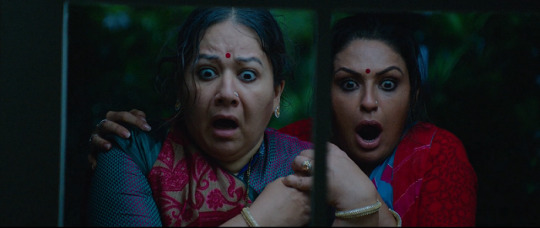
Ayesha Raza and Ashwini Kalsekar in Laxmii (2020). Courtesy Fox Star Studios/Cape of Good Films/Shabinaa Entertainment/Tushar Entertainment House.
Also read:
‘Laxmmi Bomb’ is a remake of a movie about a vengeful spirit and an unwilling medium
https://www.covid19snews.com/2020/11/09/laxmii-review-in-kanchana-remake-akshay-kumar-wages-war-in-a-sari/
0 notes
Text
Our New Normal
Now that we’ve been in Mumbai for 3 1/2 months, I feel like I can say we are settled into into our new normal. Of course, the adjustment process will likely continue in fits and starts much longer, but it feels like we have turned a significant corner. When I was in Kerala for work last month, I would tell people there, “I’m going home on Wednesday.” By that, I meant back to Mumbai. There was absolutely no hesitation when I was saying the word “home.” It felt good.
Our new home no longer shocks me much anymore — a big sign that I have shifted. For instance, I still notice, but am no longer surprised, by the countless motorcyclists I see doing crazy dangerous stuff. A popular one: Daredevil drivers speeding through terrible traffic, their helmets hanging on their handlebars, their mobile phone clamped between their ear and shoulder. And another common one: a family of four, dad driving, mom holding two month old, three year old sandwiched between mom and dad. Dad is wearing a helmet but no one else is. Also recklessly speeding. Do I like almost being run down by them? Nope. Am I surprised by them anymore? Nope.
I wish I could get photos — or, better yet, videos — of these insane motorcyclists but I am always too focused on my own safety (or Anamika’s safety if she is out walking with me) to stop and take pics.
And who is the least surprised by anything anymore? Anamika, of course. Anamika actually adjusted long back. She talks about our friends in the US and about Somerville (For example, this morning when we were talking about getting some Christmas decorations, she said, “We can buy a Santa for Somerville and for India.”) but it’s matter-of-fact now. She no longer seems confused by her dual-country existence; in fact, it’s been a while since she’s hesitated when trying to figure out where we now live. And she is always proudly telling people: “I go to the American School of Bombay — Kurla Kohinoor Campus!” Man, do I wish for her unformed vocal cords. Anamika’s pronunciation of Hindi is impeccable. Still, when I ask a rickshaw driver to take us to Kurla Kohinoor, I am met with blank stares until I have said it four different ways (all of which sound totally the same to me). :-) She on the other hand says it like a pro.
We are connecting with other folks in our apartment compound. Especially Anamika. Our compound has the friendliest group of security guards and cleaning staff. Anamika enthusiastically greets them: “Good morning Arvind Sir!” “Good night, Felix Uncle!” She often hangs out with them and regales them with stories all in English. They understand none of it but politely nod and smile. And they really look out for her. We have a tiny playground space in our compound. When she fell off the swing there, Wilson Uncle, one of the men who cleans the buildings, came running to fetch her — and to tell off Rahul, who might have pushed her a bit too vigorously, for being a negligent parent. :-)
There’s also a doodh wallah (milk man) who delivers milk to the apartments in our compound every morning. Since it such a novelty, Anamika used to love opening the door and ceremoniously accepting the packets of milk before ferrying them off to the fridge. Sadly, the novelty is gone so she barely ever runs to the door to get the milk from him anymore. Poor guy use to be greeted by an adorable 3 1/2 year old brimming with excitement, and now all he gets is a middle aged or elderly person accepting the goods at the door. But Anamika’s enthusiasm has not entirely worn off. This past week, we were walking down the stairs in our building and she saw the doodh wallah on the ground floor waiting for the lift. She shrieked, “It’s the doodh man!” which sounds really funny to an American (that would be me) who thinks she’s saying, “It’s the DUDE man.” A bit redundant, no?
Our compound is gated but the gates are never locked. (thank goodness! A gated community is not mine or Rahul’s style.) So there’s a group of kids from the neighboring slum, mostly boys, who often come and play in the playground. Anamika loves them! Her favorite is ten year old Sushil. A very handsome and charming boy, he’s got a winning smile, a mischievous gleam in his eye, and a love of attention. So he and I chat a bit in Hindi and he mostly clowns around for Anamika. The genuine belly laughs he gets out of her are impressive!
Since Anamika goes to the American School, she had Thanksgiving break. We did not celebrate, but we had a fun stay-cation. One of the many things we did that long weekend was do a long day trip to Elephanta Island with another family we know. Elephanta is an hour ferry ride from the Gateway of India in South Mumbai. On the island are caves with fourteen hundred year old carvings and monkeys galore. It’s a fun place to marvel at the stone work, play hide and seek, and strategize how best to avoid the aggressive monkeys. Cows are ubiquitous in India, and typically vey docile. But Rahul encountered one that followed him and head butted him, in hopes he would drop Anamika’s roasted corn. Rahul emerged victorious from the stand-off — but barely! Since we could not stop laughing at the whole thing — and our pal Jessie was so busy recording the encounter — our friends and I were of no help. (Sorry, my Love.)

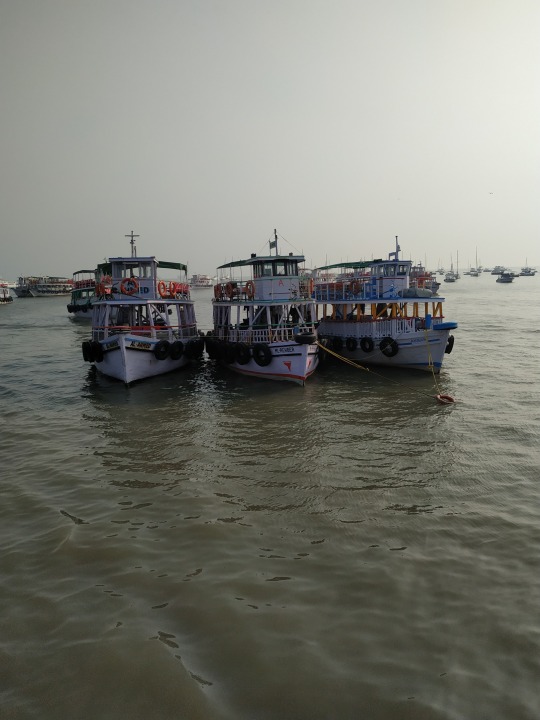
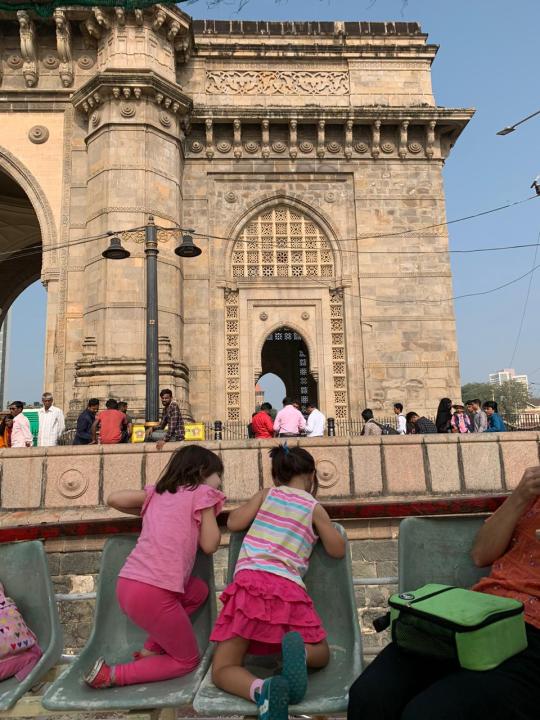
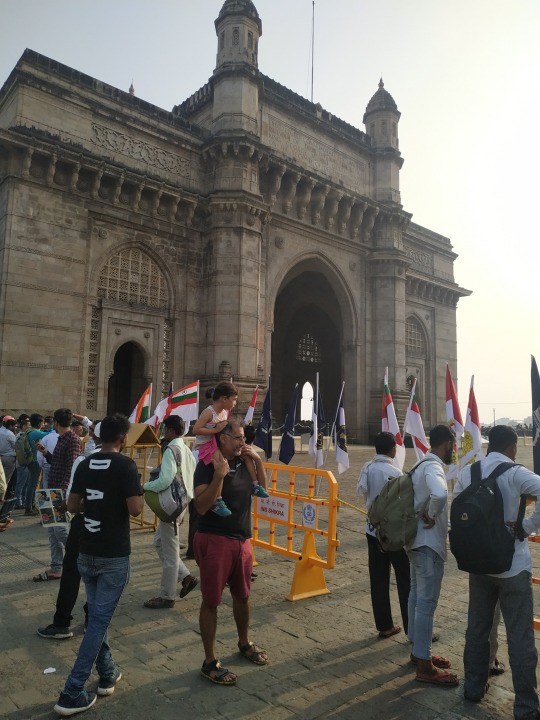

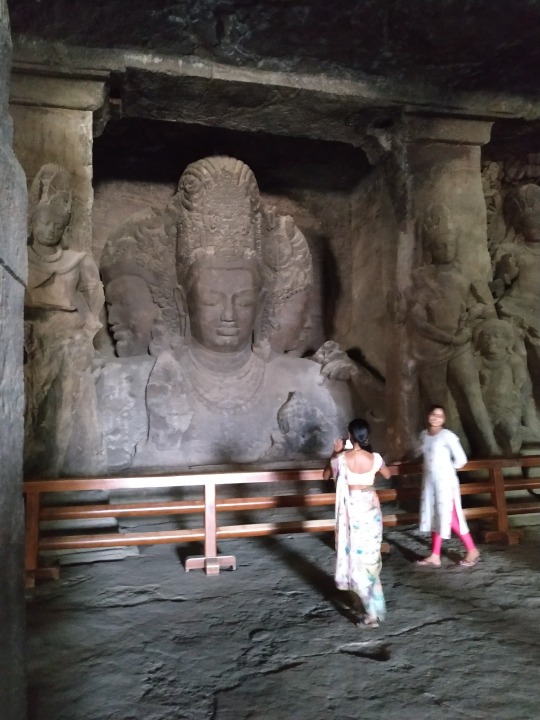


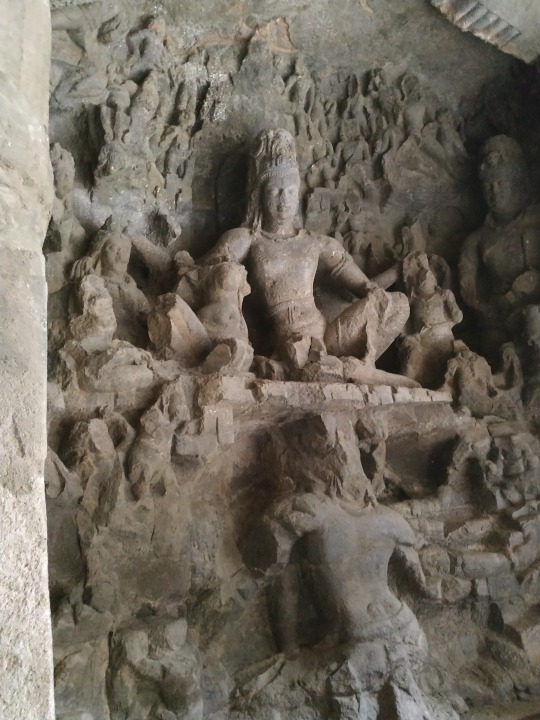
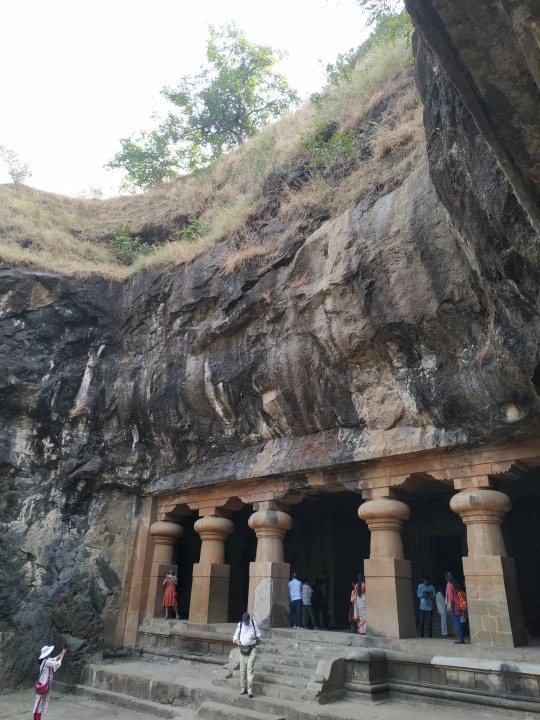
India is not one of the cleanest countries in the world (to put it mildly). Prime Minister Modi even started a public cleanliness campaign called “Swachh Bharat” which includes raising public awareness and doing some public works projects such as toilet building. In my observations over the past many years of coming to India regularly, it seems to be working. People used to blithely throw trash on the roads and footpaths, and men would regularly drop their trousers and pee anywhere they felt the urge. This kind of behavior is not as common anymore, though it still happens more than it should. I find most of Modi’s policy initiatives abhorrent (Rahul and I often play the “Who’s a Worse Leader? Modi or Trump?” game.), but I will give him credit for Swachh Bharat. It’s not as successful as the Modi government claims (especially the Open Defecation Free India part of the campaign), but it seems to be working in many other ways.
One of my proudest moments since moving to India occurred on the ferry ride to Elephanta -- when I had my chance to do my Swachh Bharat bit. A ferry passenger had the audacity to throw a plastic bag into the sea from the ferry, and I thought it my civic duty to make it clear that what he had done was beyond the pale. I resorted to public shaming. In an intentionally loud voice I told him he was a disgrace because he was not honoring the Prime Minister’s “Swachh Bharat” campaign. An unfortunate number of Indians fawn all over Modi, so basically telling someone who likely reveres the Prime Minister that he is disrespecting the Prime Minister, I thought, was a small stroke of genius. :-)
And we are now starting to prepare for Christmas. Anamika is one lucky kid (and we are lucky adults) since we celebrate Indian holidays, as well as the ones that have gone more global, such as Christmas. We do the endless fall festivals here, culminating in Diwali, and now we are heading into Christmas. Our neighborhood is adorned with a variety of secular (It seems everyone loves Santa Claus!) and non-secular (many Roman Catholic churches in Bandra, so Christ is everywhere) decorations. We have a medium sized fake Christmas tree in our livingroom, decorated with a combination of homemade ornaments (compliments of Rahul and Anamika), as well as ones bought on Hill Road. We recently went to a birthday party at the Taj Lands End Hotel where they have a gigantic, beautiful christmas tree in their lobby. As we walked past it, Anamika declared without a hint of envy or irony, “Oh. It’s just a bit bigger than our tree.” Given that it’s probably twenty feet taller than our tree, I cracked up.
You be the judge...
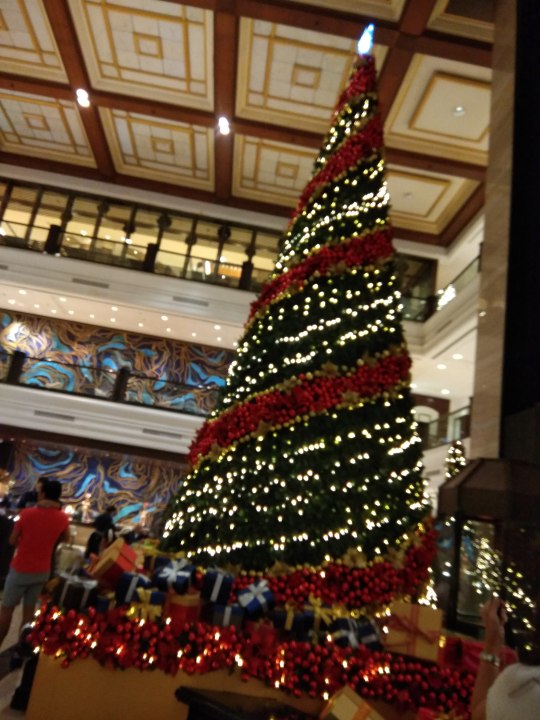

Christmas shopping on Hill Road, a street in our neighborhood chock full of shops of all kinds (You want glitter and glue? Go to Hill Road. You want cheap sandals? Go to Hill Road. You want pain puri? Go to Hill Road. You want Christmas decorations in the month of December? Go to Hill Road.), is a total hoot. Normally, shopkeepers and hawkers fill the sidewalks with their wares; people even set up blankets with their goods piled high on top of them in the streets. During this season, it’s even more chaotic. Ad-hoc Christmas shops (nothing more than card tables set up in nooks and crannies all over Hill Road) pop up with colorful stars, Santas, reindeer, snow globes, you name it. Rahul, Anamika and I hit Hill Road to round out our Christmas tree decoration collection. It was quite the experience as we sweated bullets (I never associate heat and humidity with Christmas!) keeping Anamika safe from all the traffic as it whizzed by, as well as keeping her from breaking every snow globe on Hill Road. :-)
Since, unlike most shops that are directly on the street, this one had a safe stretch of sidewalk in front of it, I actually was able to get one photo of Anamika doing some Christmas shopping on Hill Road...
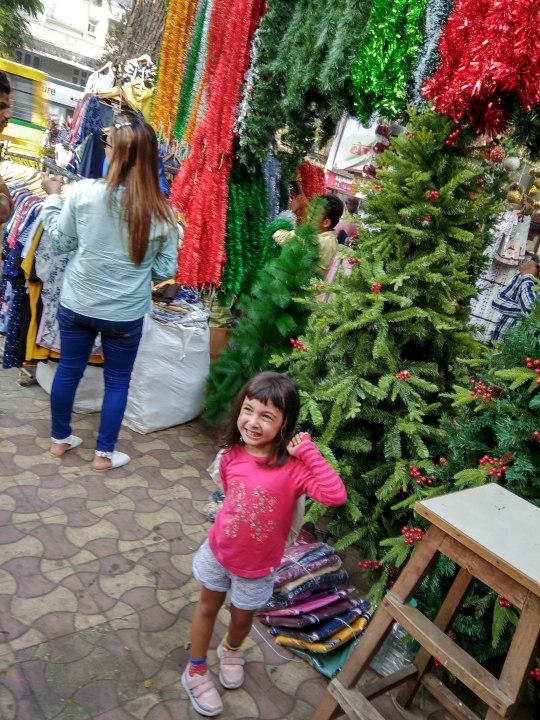
And we are starting our favorites (a sure sign of feeling at home)…
favorite bookstore: Trilogy (Amazingly curated by amazing bibliophiles — and just plain nice people — it’s the antidote to box book stores…Trilogy is down a cramped, smelly alley, so it’s almost impossible to find. Once you push through the front doors, and into their intimate, beautiful space, the world melts away. They have a feminist book section, too! Need I say more?!)
favorite cafe: The Bagel Shop (yes, that’s the name. The bagels are not NYC bagels, but they are not bad. Their homemade juices are amazing. Living in a tropical zone with a huge variety of fresh fruits has its perks! And their outdoor patio with fans whirring all over is a winner.)
Rahul and Anamika playing the Dot Game at The Bagel Shop...

(Because we get questions about our water bottles, let me explain: Anamika’s water bottle is a pink Peppa Pig one; Rahul’s is a pink Hello Kitty one; mine is boring old blue.)
favorite road to walk on: Veronica Road (Being narrow and twisty, traffic is at a minimum. It’s also cool since it’s flanked by old colonial era buildings and random Catholic statues and mini shrines.)
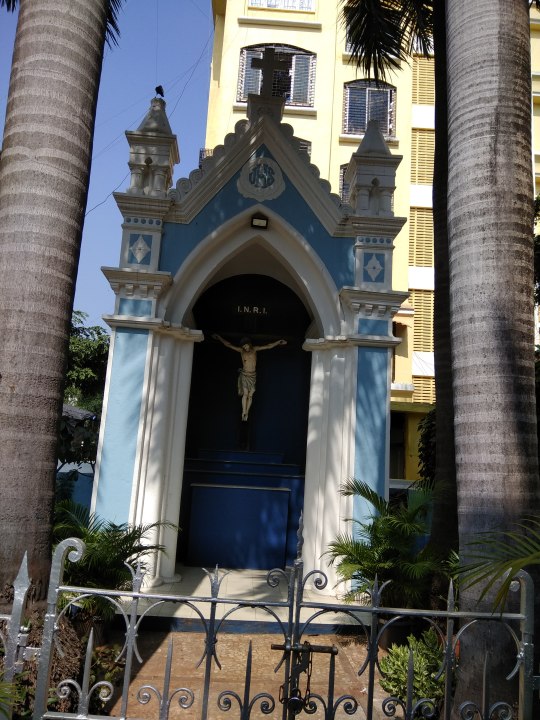
favorite chai: a cup at 17/31 MHB Colony (That would be our home. I swear Ambubhai makes the best cup of chai in all of Mumbai. Perhaps in all of India. Come try it and see for yourself!)
favorite place to go running: Bandra Reclamation Pathway (A five minute run past the slums near our apartment takes us to a sweet pathway along one of the bays of the Arabian Sea. When it’s not too smoggy from pollution, we see downtown Mumbai across the water, and I really enjoy all the palm trees they’ve planted along the pathway.)
favorite place for a date: The Saltwater Cafe (Rahul and I still don’t get out much, but we do get out more than when we were in Somerville and Dadi and Dada (Grandma and Grandpa) were close to 8000 miles away.)
favorite weekend activity: When we’re not busy with Anamika’s packed social calendar (This weekend, she had three birthday parties and a christmas event to attend. I’m not at all jealous of the fact that she has so many friends here. ;-) ), you can often find us swimming at the pool at Sun n Sand Hotel right on Juhu Beach, right on the Arabian Sea. We pay for day passes and swim to our hearts’ content.

A random thing about living in Mumbai that I love: the flowers. They are simply gorgeous. Mumbai is truly an urban jungle — emphasis on “urban.” And it is easy to despair the lack of green space here. But when the riot of flowers confronts my senses, I am reminded that nature does exist, and that beauty is all around. (Sorry for the corny Hallmark card quality of that phrase.)
I took this pic one morning as I was walking to my yoga class…

One other thing I love about our neighborhood are the murals that surprise you on various walls. Of course, I particularly like this one...
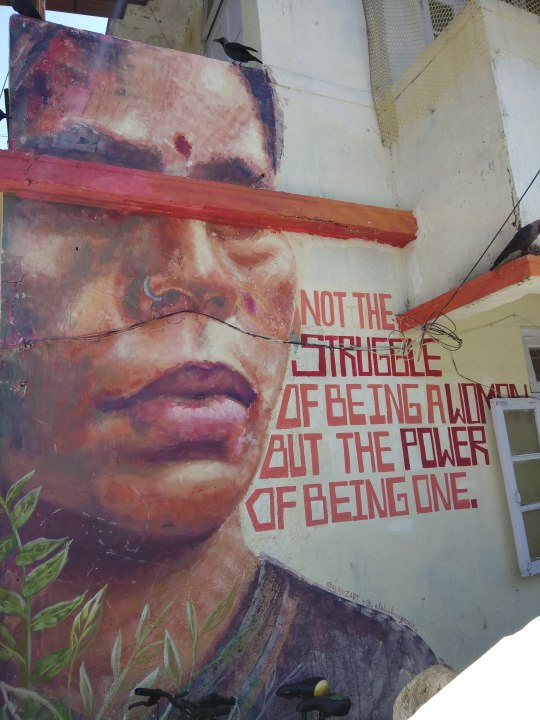
Not to end on a sad note, but life ain’t all a bowl of cherries. One thing Rahul and I are not getting used to — nor should we — is seeing so many desperately poor children on the streets. Desensitization, which can happen so easily, is a soul killer, so we are trying to avoid it. Even worse, it maintains the status quo. On Friday night, we were driving to a little school christmas concert. On the left of our uber, we were approached by a man selling christmas accessories (street hawkers, selling everything from tissues to plums and everything in between, are so common here), including reindeer antler headbands, one of which Anamika just had to have. So as I was making that purchase out of the window on my side of the uber, Rahul was giving money to two poor little girls who had approached on his side of the uber. How’s that for a moment of glaring inequality?!
1 note
·
View note
Text
Points and Crossings: Point and Crossings are peculiar arrangement used in permanent way (railway track) to guide the vehicle for directional change. A point consists of one pair of tongue rails and Stock Rails with necessary fittings.Crossing is a device in the form of V-piece introduced in the track to permit movement of wheel flange at the inter section of two running lines.It has gap over which the wheel tread jumps.The track portion between point and crossing is is called lead.
The points and crossing are the vital components of track asset; necessary for diversion of traffic from one track to another track, such diversion may be necessary for giving precedence to faster trains in the same direction, giving passage to a train moving in the opposite direction or for connecting places not on the direct line of track.
Constituents:
Turnout- The term denotes points and crossing with the lead rails.
Tongue rail – It is tapered movable rail, connected at its thickest end to running rail.
Stock rail – It is the running rail, against which a tongue rail functions.
Switch – A pair of tongue with stock rail with necessary connections and fittings.
Points – A pair of tongue rail with their stock rails are termed as points.
Crossing – A crossing is a device introduced at the junction where two rails cross to permit the wheel flange of railway vehicle to pass from one track to another track.
Heel of switch – It is an imaginary point on the gauge line midway between the end of lead rail and the tongue rail in case of loose heel switches. In case of fixed heel switches, it is a point on the gauge line of tongue rail opposite the center of heel block.
Track Fastening: A rail fastening system is a means of fixing rails to sleepers.
Rail fastening types
Rail spike with baseplate above the tie
Track joint and chairs
Pandrol ‘e-Clip’ fastening
Pandrol ‘fastclip’ fastening
Tension clamp fastening
Bolt clamped fastening
Steel spring keyed rail in chair
Signal Boards: Track-side signs and symbols appear on the left hand side of the track (the assistant driver’s side), usually placed a little high and painted on a yellow board.
Speed Limit: Speed is indicated on yellow triangular board written is black. For premium trains like Rajdhani and Shatabdi, speed is indicated on blue board and written in white.
Termination Indicator: Termination of Speed limit. P for passenger and G for goods.
Caution Indicators: Arrow-shaped boards pointing to the left or right. These indicate special restrictions on the track and caution orders in effect; the direction of the arrow indicates which track the restriction applies to.
Whistle Indicators: ‘W’, or ‘W/L’ on a square yellow board. The ‘W’ is a general whistle indicator while the ‘W/L’ stands for Whistle for Level Crossing. The latter is also seen in Hindi with the characters ‘see/pha’ == ‘seetee bajao – phatak’).
other signals will be discussed in coming posts.
Signals: A signal is a mechanical or electrical device erected beside a railway line to pass information relating to the state of the line ahead to engine drivers. The driver interprets the signal’s indication and acts accordingly. Typically, a signal might inform the driver of the speed at which the train may safely proceed or it may instruct the driver to stop.
Semaphore Signals: One of the earliest forms of fixed railway signal is the semaphore. These signals display their different indications to train drivers by changing the angle of inclination of a pivoted ‘arm’. The semaphore arm consists of two parts: A wooden or metal arm (or “blade”) which pivots at different angles, and a spectacle holding colored lenses which move in front of a lamp in order to provide indications at night. Usually these were combined into a single frame, though in some types (e.g. “somersault” signals in which the arm pivoted in the center), the arm was separate from the spectacle. The arm projects horizontally in its most restrictive aspect; other angles indicate less restrictive aspects.
4 Color Light Signals: The introduction of electric light bulbs made it possible to produce colour light signals which were bright enough to be seen during daylight. These at first were “short-range” signals, used in low-speed applications. Improvements in signal glassware increased the daylight viewing range to that of “medium-range” signals. “Doublet lens” combination wherein an outer clear Fresnel lens was sealed with inwards facing ribs to an inner glass of the desired colour with ribs facing the outer lens. Both inner and outer exposed surfaces were therefore smooth, avoiding dirt accumulation.
Position Light Signals: A position light signal is one where the position of the lights, rather than their colour, determines the meaning. The aspect consists solely of a pattern of illuminated lights, which are all of the same colour. Small position light signals are used as shunting signals, while the main signals are of colour light form.
Cab Signalling: Locomotives are equipped to display cab signals. These can display signal indications through patterns of lights in the locomotive cab, or in simple systems merely produce an audible sound to warn the driver of a restrictive aspect.
Power: Signals and other equipment (such as track circuits and level crossing equipment), are powered from a low voltage supply. The specific voltage varies with the country and equipment used. The reason behind this is that the low voltage allows easy operation from storage batteries. Batteries are the primary power source, as mains power may be unavailable at that location. In urban built-up areas, the trend is now to power signal equipment directly from mains power, with batteries only as backup.
Catenary:
A catenary is a system of overhead wires used to supply electricity to a locomotive, streetcar, or light rail vehicle which is equipped with a pantograph.
Unlike simple overhead wires, in which the uninsulated wire is attached by clamps to closely spaced crosswires supported by poles, catenary systems use at least two wires.
Overhead line is designed on the principle of one or more overhead wires (or rails, particularly in tunnels) situated over rail tracks, raised to a high electrical potential by connection to feeder stations at regular intervals. The feeder stations are usually fed from a high-voltage electrical grid. This wire is attached to the contact wire at regular intervals by vertical wires known as “droppers” or “drop wires”. It is supported regularly at structures, by a pulley, link, or clamp. The whole system is then subjected to a mechanical tension.
Section Break: To allow maintenance to the overhead line without having to turn off the entire system, the line is broken into electrically separated portions known as “sections”. Sections often correspond with tension lengths as described above. The transition from section to section is known as a “section break” and is set up so that the vehicle’s pantograph is in continuous contact with the wire.
Tensioning: Catenary wires are kept at a mechanical tension because the pantograph causes mechanical oscillations in the wire and the wave must travel faster than the train to avoid producing standing waves that would cause wire breakage. Tensioning the line makes waves travel faster. It consists of a single large tensioning pulley (basically a ratchet mechanism) with a toothed rim, mounted on an arm hinged to the mast. The downward pull of the weights and the reactive upward pull of the tensioned wires lifts the pulley so its teeth are well clear of a stop on the mast. The pulley can turn freely while the weights move up or down as the wires contract or expand.
Token Exchange: In railway signalling, a token is a physical object which a train driver is required to have or see before entering onto a particular section of single track. The token is clearly endorsed with the names of the section it belongs to. A token system is more commonly used for single lines because of the greater risk of collision in the event of a mistake being made by a signaller or traincrew, than on double lines.
Track Equipment Points and Crossings: Point and Crossings are peculiar arrangement used in permanent way (railway track) to guide the vehicle for directional change.
0 notes